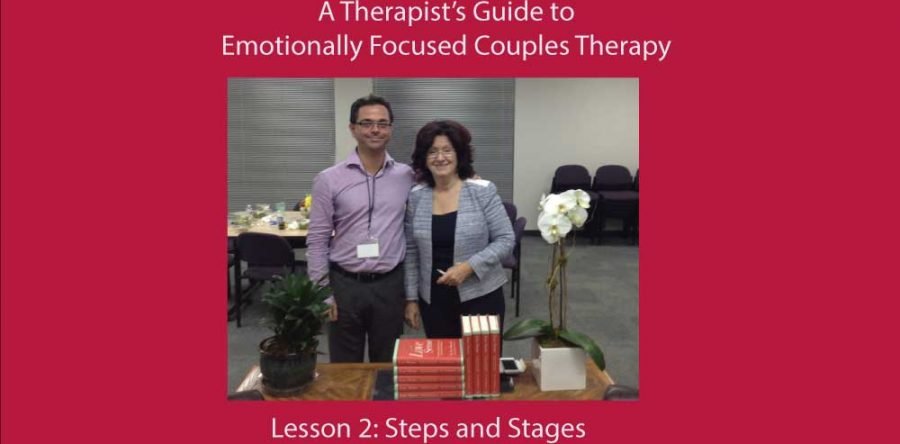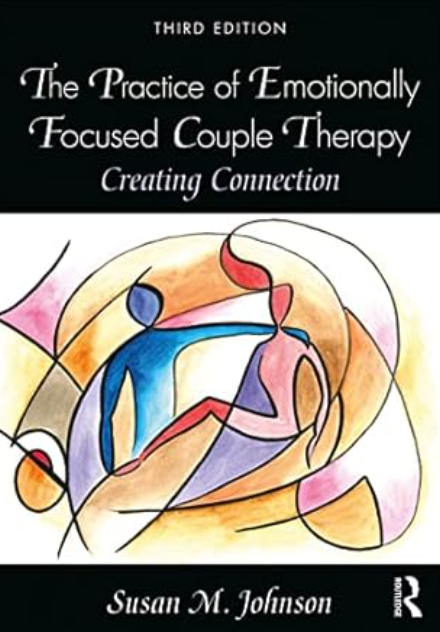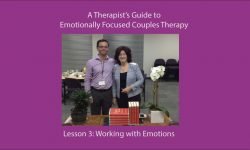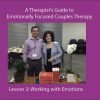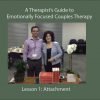Steps and Stages of Emotionally Focused Couples Therapy
In today's lesson we will be looking at the sequence couples have to go through to complete a full course of emotionally focused couples therapy. As we saw in part 1, EFT provides an attachment understanding of why couples end up having relationship problems. With this in mind, part 2 provides a roadmap for how couples can undo these problems by going through a series of steps and stages that will ultimately provide them with the anti-dote or cure (a secure attachment). For the emotionally focused couples therapist helping couples get there means following a clear road map and it is this roadmap that I will be presenting here...
Lesson 2: What You will Learn
- Understanding the Steps and Stages of a Successful Emotionally Focused Couples Therapy
- Understanding key characteristics of the EFT method that are necessary for true change to occur
The Steps and Stages of EFT:
The work of EFT is accomplished in 3 stages. You must first complete one stage before moving on to the next. In the following section I will explain each stage of the therapy and delineate the steps within each stage.
Stage 1 of Emotionally Focused Couples Therapy:
In stage 1, which can take 10-15 sessions, the goal is to defeat the negative pattern that has been fueled by the insecure attachment cues each partner is emitting to the other. This involves reframing the couple’s negative interactions within an attachment perspective so the meaning of each person’s behavior changes and makes sense in a new way. For example, the pursuer must have a chance to see the hidden fears and longings of the withdrawer, and to understand the emotional and mental withdrawal not as a sign of a lack of caring or indifference, but as a desire to protect the relationship from further damage and destabilization. The withdrawer, on the other hand, must be given a window into the separation distress, loneliness, and longing for connection that the pursuer is currently expressing as criticism, anger, and rejection sensitivity. The withdrawer must be given an opportunity to see the vulnerable rather than the hostile side of the pursuer so they understand that the pursuer’s criticism is an expression of desire for the withdrawer and not a testimony to their distaste or contempt of the withdrawer.
The process of completing stage 1 consists of traversing a number of steps:
Step 1:
Step 1 is to join with each partner of the couple at the level of their conscious experience and really try to get how each partner experiences their problems and grievances. The best way to do so is to validate and normalize each person’s experience and to not invalidate their anger or defense mechanisms. Each partner needs to feel that how they act and how they feel makes complete sense given their (or their nervous system’s) interpretations of what is going on in the relationship. At this step you will also spend some time assessing each partner individually to get a sense of whether there are any contra-indications for EFT. Contraindications include the presence of emotional or physical intimidation, physical or emotional abuse, current affairs, or lack of mutual investment or commitment.
Step 2:
Once partners feel like you understand them at more of a surface level and have a good sense of the problems they each experience in their relationship, you will move into step 2, where you help them to see how their behaviors are interlinked in a negative cycle of attachment distress. The focus here is more on a cognitive understanding and awareness. Each person will begin to understand their own internal process better (how primary emotions are defended against by secondary emotional reactions, how secondary emotional reactions arise in response to particular cues or perceptions, how interpretations lead to actions, etc.). They will also begin to understand how their own actions impact the internal process in their partner, and how their partner’s actions impact their own internal process. At this step the couple will begin to understand their relationship from a circular logic or systems perspective and to realize that they each are playing a role in perpetuating their relationship distress through their reactivity to each other.
Step 3:
In step 3, once couples understand their negative cycles in a more cognitive or cursory way, they will each be invited to move deeper into the often hidden underbelly of their angry reactions or their fearful withdrawal. They will be helped to move into their primary emotions and their underlying attachment fears, and will be helped to articulate these emotions first to themselves and then to their partner. This will produce a positive shift in their interactions because they will now be able to communicate with each other more from their heart (what they really feel deep down), and get to experience a shift in how their partner therefore is able to respond to them (more empathically or engaged). As partners communicate their primary emotions and attachment fears, they are learning to send a clearer and more positive attachment signal, which their partner is now able to hear, and this elicits a positive attachment behavior of caring and compassion in their partner.
Step 4:
In step 4, the couple is invited to take a step back from their interpersonal process to assess what has been accomplished by shifting into a more vulnerable stance with each other and to analyze how they got there. Through this bird’s eye perspective the couple is helped to integrate their experiences of step 2 and 3 into a new attachment understanding of their negative cycle. They no longer see each other the same way, but understand that they are each fighting for the same cause albeit in different ways. In other words: they both care deeply about their relationship and this is what is causing their negative reactions to perceived threats. At this step, the therapist will celebrate the couple’s accomplishments and help them solidify their new understanding of their difficulties through an attachment lens.
Summary of Stage 1 of EFT:
To summarize: the first 4 steps that comprise stage 1 consist of the following:
Step 1
Rapport building and initial assessment of relationship
Step 2
Identifying and understanding the steps of the negative cycle the couple is caught in
Step 3
Helping couple uncover and communicate more vulnerable primary emotions and attachment needs and fears that were previously invisible or unexpressed
Step 4
Help couple step back and see the big picture, now from an attachment frame
Stage 1 has been completed once the couple has been able to excavate and integrate previously unavailable knowledge about themselves and their partner that helps them understand their negative cycle in a much more comprehensive and accurate way. Instead of taking another spin in the negative cycle, they can now stand back from it, know where each person’s reactions are coming from, and not react as automatically or defensively as they used to. The goal of cycle de-escalation has been accomplished, and the couple can now move on to stage 2, which is defined as changing interactional positions and creating new bonds.
Stage 2 of Emotionally Focused Couples Therapy:
In stage 2, the goal is for the couple to practice expressing their primary feelings and attachment needs and fears in a way that leads their partner to both hear and respond to these feelings in a way that meets the attachment need. Once partners know how to re-establish a secure connection when they are feeling anxious, lonely, or insecure, they build a more resilient relationship that can withstand temporary threats or breaches without the attachment alarm system causing partners to go off the rails.
The second stage is different from stage 1 in the sense that the partners are no longer reactive or negatively activated by the smallest things the other partners says or does, or doesn’t say or do. The goal of the therapy can thereby shift from a focus on deescalating the couple’s cycle, to practicing the kind of communication that builds a positive, attuned, and responsive attachment system that can weather future storms.
The steps in stage 2 consists of the following:
Step 5
Help each partner (one at a time) explore and identify with disowned or suppressed fear-based or shame-based views of self and other that underlie and cause them to engage in self-protective behaviors (abandoning withdrawal or critical pursuit)
Step 6
Promote acceptance by each partner of the other person’s vulnerabilities and fears (“I don’t think less of you, I don’t see you as weak, I feel closer to you now”)
Step 7
Help each partner reach through their fears to express their attachment needs, longings, and wants, and get the experience that their partner is able to meet, respond to, or care for these needs.
Stage 2 is different from stage 1 in that the work here goes a lot deeper into the historical reasons for each person’s view of self and view of others.
Building a Secure Bond:
Each person typically enters into adult relationships with bruises and developmental traumas that have taught them negative lessons about themselves or others. These models of self and other are often what get activated by the danger cues emitted by their current partner and are what cause each person to cope by either withdrawing/ avoiding or pursuing/ minimizing distance. When these self-protective coping mechanisms are temporarily suspended and partners are invited to really stay in their fears or go deeper into their doubts about self and others, they are able to become more aware of aspects of themselves which they have been trying to silence, deny, or run from (step 5). They are now helped to expose their vulnerable underbelly of fears about their ability to depend on others, be loved and accepted for who they are, be good enough, not be too much, etc. and to have an experience that these fears and self-doubts can have a place in their relationship, can be talked about, and can lead to empathy and compassion instead of disgust and rejection (step 6). This expands the relationship to include a fuller engagement with the true selves of each partner and gives them the sense that they don’t need to hide aspects of themselves to maintain the respect or love of their partner. Instead of turning away from each other when such models of self or other are activated, they can now turn towards each other and count on each other to help them with these fears and doubts. Furthermore, as they each get more in touch with their most vulnerable self and their deepest fears and beliefs about relationships, their deepest emotional attachment needs also become clearer, since these needs often consist of the anti-dote to their fears. For example, if I fear that my partner will be disgusted with me if they know that I am scared of not measuring up or being good enough, then the attachment need I have is to be reassured of my partner’s love for me and respect for me even when I reveal my vulnerability (step 7). Step 5-7 therefore often bleed into each other naturally, such that when a partner is helped to become more aware of the deepest fears that block them from revealing their vulnerabilities to their partner, they also soon find themselves getting in touch with what they need to feel more at peace or more secure in their relationship.
The work in stage 2 typically starts with the withdrawer who is gradually helped to get in touch with the deeper fears and beliefs about self and other that are hidden underneath the tendency to withdraw (step 5). As they reveal this first to themselves, they are then also helped to communicate their beliefs and fears to their partner. As they take this risk of relating to their partner from their most authentic or whole self, the partner is helped to provide a reassuring, warm, or compassionate emotional response (step 6). Getting in touch with the fears and beliefs about self and other that have necessitated their withdrawal as a defensive or self-protective mechanism also helps the withdrawer get in touch with the anti-dote to withdrawing. This anti-dote is the possibility of receiving that which they never got or didn’t think would be possible. For the withdrawer this often entails a feeling of being accepted for who they are, getting the benefit of the doubt, having their efforts acknowledged, or having a right to their feelings and opinions. In step 7 they can therefore turn to their partner and say that they want to succeed at making the relationship work, but that they need their partner to acknowledge that they are trying, that it hurts when they feel talked down to, and that they need the pursuer to not be so quick to dismiss what the withdrawer brings to the relationship. This renewed emotional engagement, which happens when the withdrawer reaches through the wall of fear that has made them withdraw, sets the stage for a new kind of connection that in turn makes the pursuer feel less alone and more encouraged to open up about their own fears. The pursuer can now go through step 5-7 themselves and trust that they are not revealing their deepest fears to a person who appears to not care and not really be available or able to hold their fears.
For the withdrawer, going through step 5-7 leads them to take up a new role in the relationship that is more assertive and present, and is referred to as withdrawer reengagement. We will study this more in a future lesson. For the pursuer, going through step 5-7 also leads them to take up a new role by bringing their softer and more vulnerable longings to the fore, and this is referred to as blamer softening. We will study this more in week 4. Both these events are referred to as key change events in EFT and are considered necessary for change to happen in the therapy.
Stage 3 of Emotionally Focused Couples Therapy:
In stage 3, the goal is for the couple to revisit some of the frequent issues or personality differences that give rise to disagreements, but now from the calmer place of a secure relationship where each partner can be more present to the needs and feelings of the other person.
The steps in stage 3 consist of the following:
Step 8
Develop new solutions to recurring problems
Step 9
Consolidating what has been learned through a new narrative of the relationship
We will not touch further on these steps here since they are not discussed that much in the literature. These later steps are often where other couples therapy approaches start since many couples therapy approaches immediately seek to help couples discuss solutions to their more immediate problems or disagreements. The point of emotionally focused couples therapy, however, is that these more surface level disagreements are much easier to come to terms with once step 1-7 have been traversed and a secure attachment bond has been re-established. Without step 1-7, these issues otherwise become mired in deeper and less conscious meanings about attachment insecurity which get in the way of resolving them.
The EFT Method:
Going through the EFT steps and stages is not simply an intellectual process. Instead it is a highly experiential process of getting in touch with feelings, communicating these feelings, and experiencing what changes inside of you when you do so.
To facilitate this level of experiential change the therapist does not primarily educate clients about the theoretical concepts that comprise the EFT model. Instead the therapist follows a highly developed method intended to help clients in get in touch with feelings and have an experience of change rather than just an intellectual understanding.
A simple illustration of how this experiential learning is accomplished is Sue Johnson's EFT Tango:

The tango of EFT is a circular process by which the therapist helps each partner develop greater awareness of their feelings, communicate these, an experience the change that results from doing things in a new way:
- First the therapist notices or helps the couple notice what is happening or going in inside or between them in this particular moment (“what is happening for you right now? What just happened inside when you saw your partner do or say X?”)
- Then the awareness is expanded or deepened to the point that something fresh or new about the experience is brought to the fore (most notably a primary emotion or attachment needs or fear)
- Then the partner who has articulated something new and more vulnerable about their experience is asked to communicate this to their partner directly (enactment)
- Then the new communication becomes the target of exploration (“what was it like to hear this? say this?”)
- Then the new positive outcome is celebrated and the couple is helped to realize cognitively that they have done something new and how this has led to a different result (“do you notice how by being more vulnerable you got a different response? How great that you are able to do this!”)
EFT Therapist Techniques:
The EFT Tango includes the use of many of key EFT interventions or techniques, including:
Validation (couples are in need of feeling like their feelings and reactions are understandable, “I get it”)
Normalization (there is nothing wrong with you)
Prizing/ affirming (you are being amazingly honest with me, you are doing great, I love that image)
Reflection (what I hear you saying is… am I right?)
Tracking/ linking (helping couples link emotions, behaviors, impact on self and partner)
Enactments (asking a partner to say something directly to the other person)
Reframes (helping couples view the meaning of an action in a new light by placing it within a more positive, broader, or more attachment oriented context)
Heightening (amplifying emotions by reflecting back what you are hearing in a way that accentuates or amplifies the emotional essence of what the client is saying)
Evocative Questions (asking questions to help partners focus inward or get in touch with feeling: what is it like when your partner says you are never there for him?)
Slow down/ interrupt (let me stop you for a moment, can we slow things down?)
Keep a focus, don’t get sidetracked (what you are saying is important, but can we go back to…)
Be transparent
Instill hope
Bottom-up psychoeducation (let teaching moments follow from events in the therapy)
Catch the bullet (when a partner does not respond well to a vulnerable enactment, the therapist steps in and helps the partner separate out the part that likes what he/she is hearing and the part that cannot take it in)
Metaprocess (look what we have just done! What was it like to share your feelings this way?)
Using proxy voice (speaking for the client as if you were them using “I” statements: “it’s like you are saying, ‘it’s so scary for me to make myself vulnerable with you’”
We will discuss therapy techniques further in a future lesson
For Therapists Who Want to Deepen their Learning:
Okay, you have now been given a first overview of EFT’s theoretical framework and the specific method and techniques. To round off your initial learning, it’s time watch an EFT session in action to see how it actually looks. A good video to start with is Sue Johnson’s live session EFT in Action. Here Sue Johnson works with a couple and narrates what her thought process is at each step of the way. The video will demonstrate in a very clear way how a couple’s distress can be viewed within an attachment framework (and the language of fear, survival, and instinct to flee or fight).
Watch: Emotionally Focused Therapy in Action with Sue Johnson - Part 2
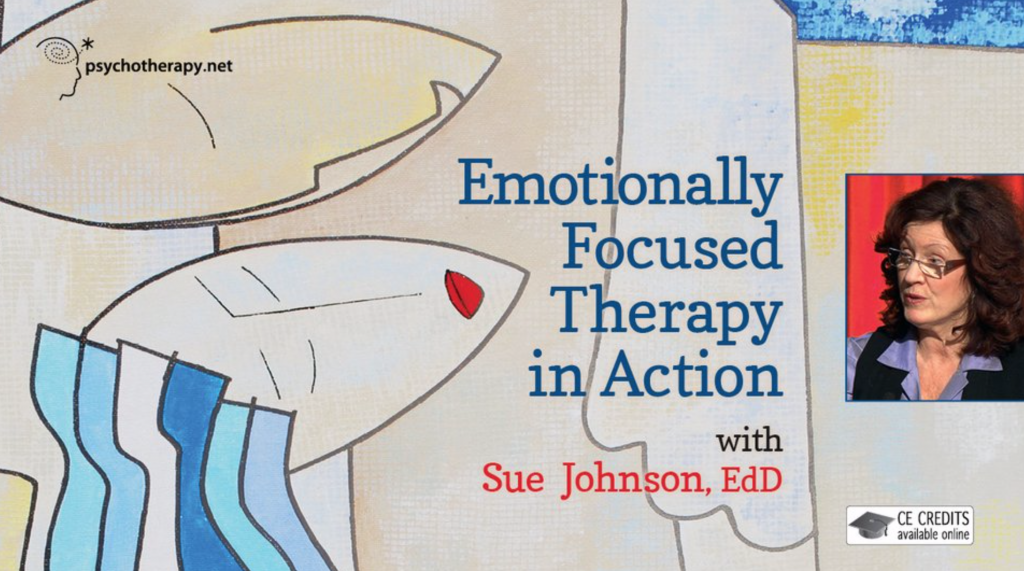
Description of video: “Matt and Rhea are dispirited from their frequent fights, and their couples therapist is struggling to contain their heated conflict and help them reconnect with positive feelings. After serving in Iraq as a helicopter pilot, Matt has returned with a PTSD diagnosis and finds himself shutting down emotionally, leaving Rhea feeling hurt, abandoned, and more like an employee than a partner. But her desperate longing to be seen and appreciated comes out as escalating anger, leaving Matt feeling overwhelmed and wanting to withdraw further. Johnson first consults with Matt and Rhea's couples therapist, aided by video clips from prior sessions. Then you'll see Johnson work with this couple in a brilliant demonstration of the subtlety and efficacy of EFT. In a single session, she helps them conceptualize their conflicts in attachment terms, gain an understanding of their negative cycle, and begin to reveal some of the vulnerable feelings that underlie their explosive anger. Commentary before, during, and after the consultation and session provides insight into her approach.”
Questions for Video:
- What attachment fears are being activated in the female? What attachment needs is she expressing? What images does she use to convey her attachment distress?
- Try to identify different types of EFT interventions/ techniques Sue Johnson is using
- Notice the language Sue Johnson uses to reframe the subjective experiences of each of the partners in terms of an attachment lens [a fear-based survival narrative]
- Notice the interventions Sue Johnson uses to make the couple more aware of their negative cycle
- Try to notice how Sue Johnson works within the steps of the EFT Tango
Additional Reading:
If you would like to read more about the theoretical assumptions of EFT including the steps and stages, I recommend:
Sue Johnson et. al: Theoretical Background to EFT (Chapter 2), pp. 13-39. In: Becoming an Emotionally Focused Couple Therapist - The Workbook.
Stay Tuned for the Next Lesson:
In the next lesson of Emotionally Focused Couples Therapy: A Step-By-Step Guide we will explore the concept of primary and secondary emotions and tracking negative cycles. Both of these concepts are essential to know about for any therapist wanting to help couples get unstuck from their dance of attachment distress...


